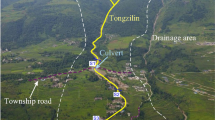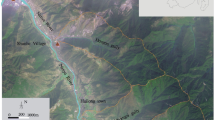Abstract
The destruction of mountain landform by forest fire often leads to the outbreak of catastrophic debris flow. In March 2020, a huge forest fire broke out in Xiangjiao Gully, seriously damaging the mountain landform and leading to the outbreak of a catastrophic debris flow on July 5th, 2021. To mitigate such disasters more scientifically, this paper analyzes the disaster characteristics of the “7·05” catastrophic debris flow and studies the cause mechanism and mitigation countermeasures. The results show that the debris flow density ranges from 1.831 g/cm3 to 1.930 g/cm3, belonging to viscous debris flow. The velocity of each section point is between 7.22 and 9.78 m/s, with huge kinetic energy. Forest fire, torrential rainfall, and gully terrain conditions combined to cause the outbreak of the debris flow. The rainfall intensity of the maximum rainfall point reached 77.84 mm, corresponding to a recurrence period of more than 200 years. The forest fire severely damaged the landform, and the high-intensity burned area reached 59.97%, which led to a surge in loose materials and wood debris. Combined with steep terrain, channel erosion and the blocking-bursting effect are prominent, leading to the scale amplification of debris flow. The peak flow of the upstream section D1 and the downstream section D6 are 308.21 m3/s and 759.08 m3/s, with the scale expanded by 2.46 times. To mitigate the harm of Xiangjiao Gully debris flow, this paper deduced the determination method of the optimal hydraulic section of a Rectangle-V-shaped drainage canal under the limited conditions. The calculated characteristic parameter of the section is m = 11.75, h2 = 0.60 m.











Similar content being viewed by others
References
Beyers JL, Brown JK, Busse MD et al (2005) Wildland fire in ecosystems: effects of fire on soil and water[M]. Fort Collins: rocky Mt Research Station
Cannon SH, Gartner JE, Rupert MG et al (2003) Emergency assessment of debris-flow hazards from basins burned by the grand prix and old fires of 2003, Southern California[J]. u.s. geol surv
Cannon SH, Gartner JE , Jakob M et al (2005) Wildfire-related debris flow from a hazards perspective[J]. Debris-flow Hazards and Related Phenomena
Cavallaro A, Ferraro A, Grasso S, Maugeri M (2012) Topographic effects of the Monte Po hill in Catania (Italy). Soil Dyn Earthq Eng pp. 97–113
Cavallaro A, Grasso S, Sammito MSV (2022) A Seismic microzonation study for some areas around the Mt. Etna volcano on the East Coast of Sicily, Italy. In book: Proceedings of the 4th International Conference on Performance Based Design in Earthquake Geotechnical Engineering Beijing China 15–17
Chen JG, Chen XQ, Chen HY, Zhao WY (2016) Characteristics of viscous debris flow in a drainage channel with an energy dissipation structure[J]. J Mt Sci 13(02):223–233
Cui P (1999) Impact of debris flow on river channel in the upper reaches of the yangtze river[J]. Int J Sedim Res 02:201–203
Cui P, Ma DT, Chen NS (2003) The initiation, motion and mitigation of debris flow caused by glacial lake outburst[J]. Quat Sci 23(6):621–628 (in Chinese)
Cui P, Wei F, Chen X (2008) Geo-hazards in Wenchuan earthquake area and countermeasures for disaster reduction[J]. Bull Chin Acad Sci
Dennis MS, Joseph EG, Jason WK (2015) Objective definition of rainfall intensity-duration thresholds for post-fire flash floods and debris flows in the area burned by the Waldo Canyon Fire, Colorado, USA[M]. Engineering Geology for Society and Territory, Cham: Springer. 2:621–624
Gabet EJ, Bookter A (2008) A morphometric analysis of gullies scoured by post-fire progressively bulked debris flows in southwest Montana, USA[J]. Geomorphology 96(3–4):298–309
Godt JW, Coe JA (2007) Alpine debris flows triggered by a 28 July 1999 thunderstorm in the central Front Range, Colorado[J]. Geomorphology 84(1–2):80–97
Guo X, Fan J, Peng C et al (2015) Thresholds of rainfall trigoerciy debris flows in Wenchuan earthquake area[J]. Mountain Research
Hu XW, Wang Y, Yang Y (2018) Research actuality and evolution mechanism of post-fire debris flow[J]. J Eng Geol (in Chinese)
Hyde KD, Wilcox AC, Jencso K et al (2014) Effects of vegetation disturbance by fire on channel initiation thresholds[J]. Geomorphology 214:84–96
Kang ZC, Li ZF, Luo JT (2004) Research on debris flow in China[M]. Sci Press Beijing (In Chinese)
Kean JW, Staley DM, Cannon SH (2011) In situ measurements of post-fire debris flows in southern California: comparisons of the timing and magnitude of 24 debris-flow events with rainfall and soil moisture conditions[J]. Geophys Res Earth Surf 116(F4):759–775
Key CH, Benson NC (2005) Landscape assessment (LA) sampling and analysis methods[M]
Lei Mingyu, Cui Yifei, Ni Junjun et al (2021) Actuality and case study on mechanism of post-fire debris flow initiated by shallow landslide[J]. J Eng Geology 29(3):786–797 (In Chinese)
Li G, West AJ, Densmore AL, Jin ZD, Parker RN, Hilton RG (2014) Seismic mountain building: Landslides associated with the 2008 Wenchuan earthquake in the context of a generalized model for earthquake volume balance[J]. Geochem Geophys Geosyst 15(4):833–844
Liu J, Jiao L, Yang H et al (2021) Numerical simulation for viscous debris flows passing through dams—a case study of the Wenchuan Yinxingping gully[J]. Landslides 18:3255–3267
Ma C, Deng J, Wang R (2018) Analysis of the triggering conditions and erosion of a runoff-triggered debris flow in Miyun County, Beijing, China[J]. Landslides 15
Miller A, Thode E (2006) Quantifying burn severity in a heterogeneous landscape with a relative version of the delta normalized burn ratio (dNBR)[J]. Remote Sensing of Environment 109(1)
Nafchi RF, Boroujeni HS, Vanani HR et al (2021) Laboratory investigation on erosion threshold shear stress of cohesive sediment in Karkheh Dam[J]. Environ Earth Sci 80:681
Nafchi RF, Yaghoobi P, Vanani HR et al (2022) Correction to: eco-hydrologic stability zonation of dams and power plants using the combined models of SMCE and CEQUALW2. Appl Water Sci 12:55
Nyman P, Sheridan GJ, Smith HG et al (2011) Evidence of debris flow occurrence after wildfire in upland catchments of south-east Australia[J]. Geomorphology 125(3):383–401
Nyman P, Smith HG, Sherwin CB et al (2015) Predicting sediment delivery from debris flows after wildfire[J]. Geomorphology 250(DEC.1):173–186.
Santi PM, Dewolfe VG, Higgins JD et al (2008) Sources of debris flow material in burned areas [J]. Geomorphology 96(3–4):310–321
Sichuan Natural Resources (2021) Rainstorm caused catastrophic debris flow in Muli County, Liangshan Prefecture, and 1042 people were safely transferred! [EB/OL]. https://mp.weixin.qq.com/s/V-mAZxRG8MaMAS-_Ke9-oQ
Short LE, Gabet EJ, Hoffman DF (2015) The role of large woody debris in modulating the dispersal of a post-fire sediment pulse [J]. Geomorphology 246:351–358
Staley DM, Wasklewicz TA, Kean JW (2014) Characterizing the primary material sources and dominant erosional processes for post-fire debris-flow initiation in a headwater basin using multi-temporal terrestrial laser scanning data[J]. Geomorphology 214:324–338
Stoof CR, Vervoort RW, Iwema J et al (2012) Hydrological response of a small catchment burned by experimental fire[J]. Hydrol Earth Syst Sci 16(2):267–285
Tan WP, Han QY (1992) Study on regional critical rainfall indices of debris flow in sichuan province[J]. J Catastrophology
Tang C, Yang YH, Su YC et al (2011) The disastrous 23 July 2009 debris flow in Xiangshui Gully, Kangding County, Southwestern China[J]. J Mt Sci 8(002):131–139
Tang C, van Asch TWJ, Chang M, Chen GQ, Zhao XH, Huang XC (2012) Catastrophic debris flows on 13 August 2010 in the Qingping area, southwestern China: the combined effects of a strong earthquake and subsequent rainstorms[J]. Geomorphology 139–140(1):559–576
Wall SA, Roering JJ, Rengers FK (2020) Runoff-initiated post-fire debris flow Western Cascades, Oregon[J]. Landslides 17(7):1649–1661
Wang XL, Wang WJ, Chang Y et al (2013) Fire severity of burnt area in Huzhong forest region of Great Xing’ an Mountains, Northeast China based on normalized burn ratio analysis[J]. Ying Yong Sheng Tai Xue Bao 24(4):967–974 (In Chinese)
Wang Y, Xiewen HU, Jin T et al (2019) Material initiation of debris flow generation processes after hillside fires[J]. J Eng Geol
Yang F, Fan X, Subramanian SS et al (2019) Catastrophic debris flows triggered by the rainfall a decade since the Wenchuan earthquake China[J]. Landslides 1:16
Yin WQ, Cao XC, Hu XW (2021) Development characteristics of post-fire debris flow and emergency response measures in Xiangjiao township, Muli[J]. J Geol Hazards Environ Preserv 32(1):12–17 (In Chinese)
You Y, Liu J, Ou G (2008) The hydraulic condition analysis and optimal cross-section design of the “rectangle –v” shaped drainage canal of debris flow[C]. IEEE Int Geosci Remote Sens Symp
You Y, Pan HL, Liu JF et al (2011) The optimal cross-section design of the “trapezoid-V” shaped drainage canal of viscous debris flow[J]. Jf Mt Sci
You Y, Liu J, Chen X et al (2022) Debris flow formation conditions and optimal characteristics of drainage canal following Wenchuan earthquake[J]. Environ Earth Sci 65(4):1005–1012
Yu Bin, Yu Ma,Yufu Wu (2013) Case study of a giant debris flow in the Wenjia Gully, Sichuan Province, China[J]. Nat Hazards 65(1)
Yu B, Wang T, Zhu Y (2016) Research on the topographical and rainfall factors of debris flows caused by shallow landslides[J]. Adv Water Sci
Zhou BF, Li DJ, Luo DF, Lv RR, Yang QX (1991) Guidelines of debris flow prevention and control[M]. Sci Press Beijing (in Chinese)
Funding
Funding of the research is supported by the Strategic Priority Research Program of the Chinese Academy of Sciences (Grant No. XDA23090403) and the Second Tibetan Plateau Scientific Expedition and Research (STEP) Program (Grant No. 2019QZKK0902).
Author information
Authors and Affiliations
Corresponding author
Rights and permissions
Springer Nature or its licensor (e.g. a society or other partner) holds exclusive rights to this article under a publishing agreement with the author(s) or other rightsholder(s); author self-archiving of the accepted manuscript version of this article is solely governed by the terms of such publishing agreement and applicable law.
About this article
Cite this article
Yang, H., Liu, J., Sun, H. et al. Characteristics, causes, and risk reduction of a catastrophic debris flow hazard on 05 July 2021 at the Xiangjiao Gully of Muli County, China. Bull Eng Geol Environ 81, 513 (2022). https://doi.org/10.1007/s10064-022-03014-1
Received:
Accepted:
Published:
DOI: https://doi.org/10.1007/s10064-022-03014-1




